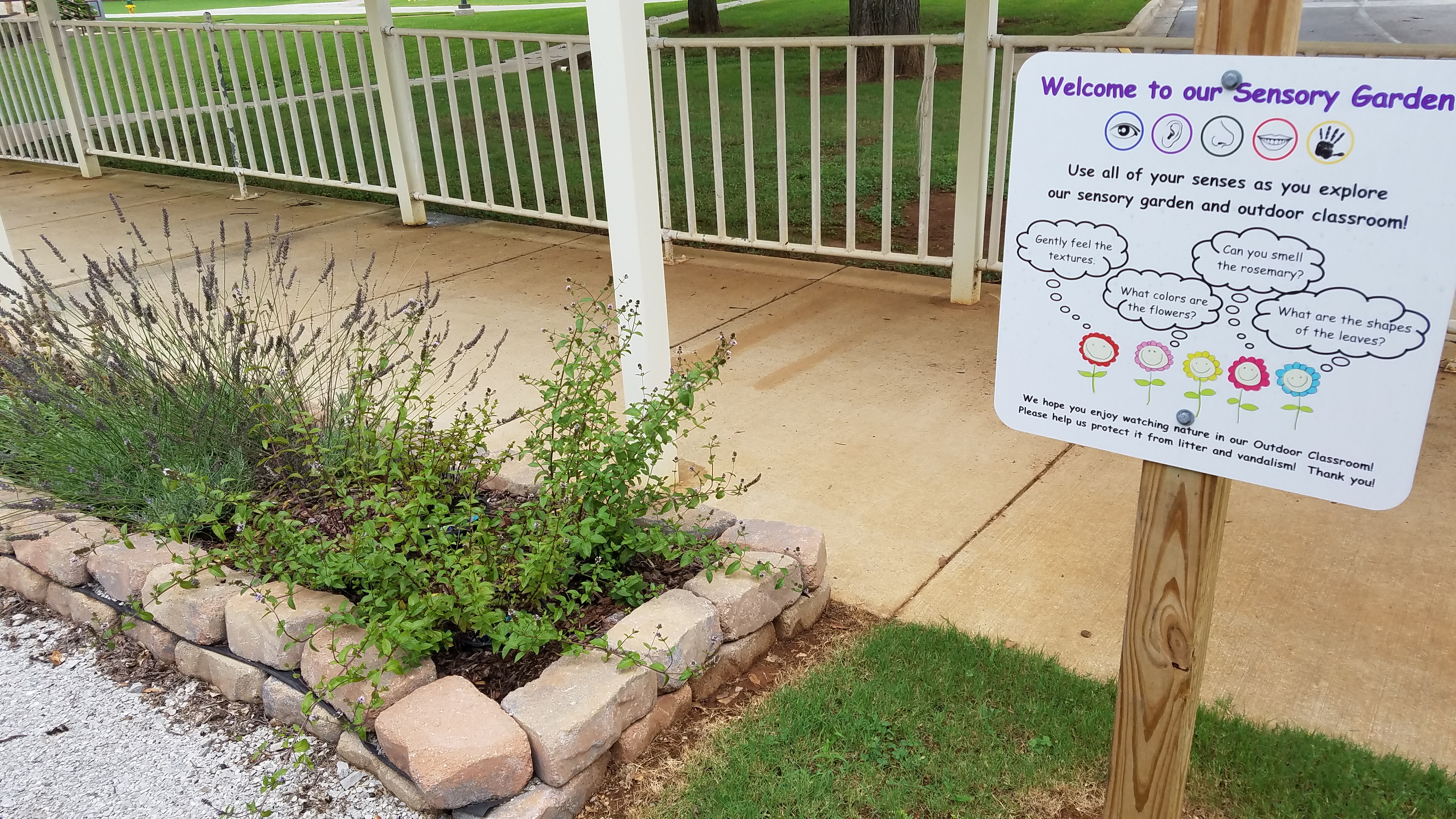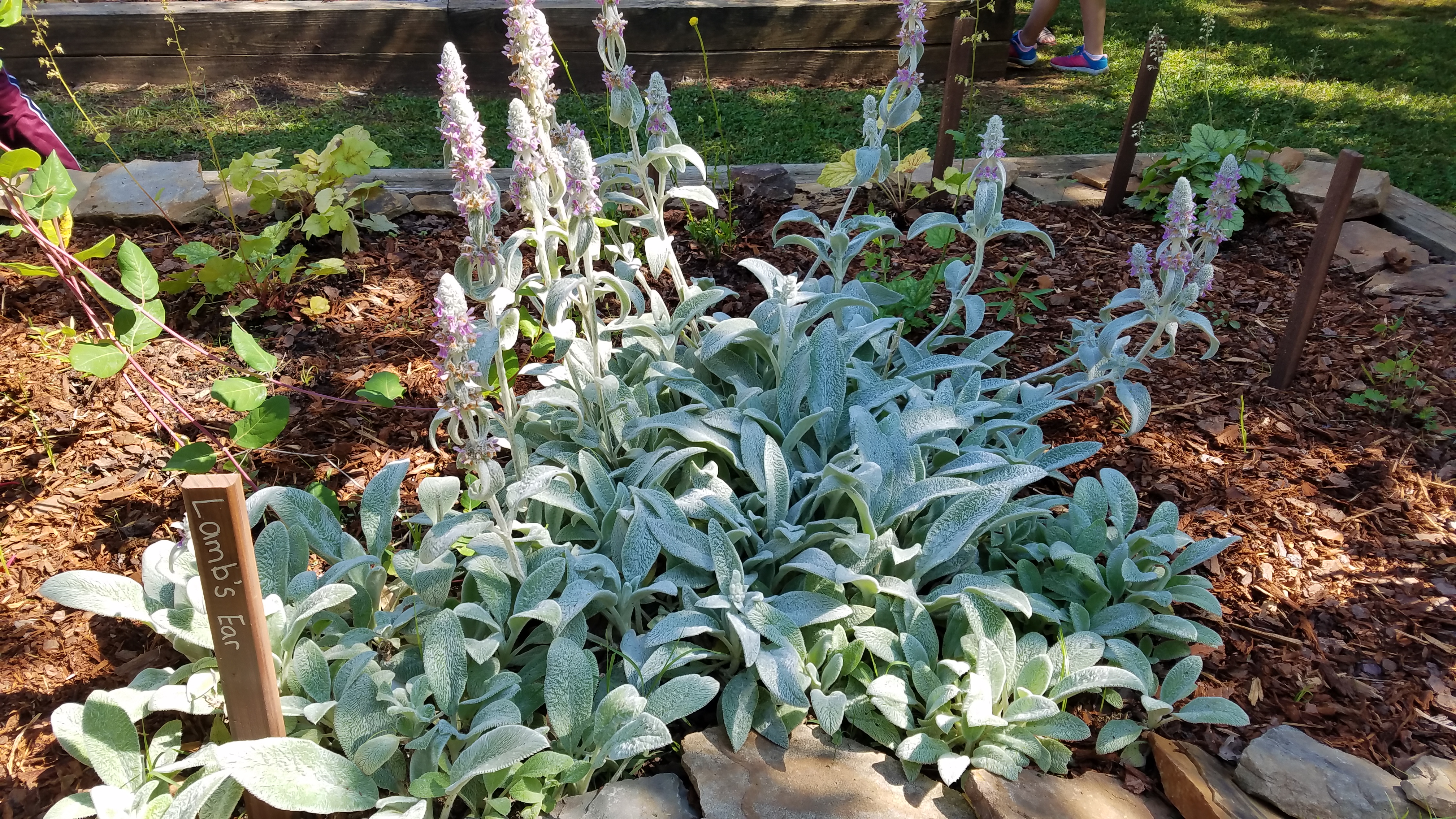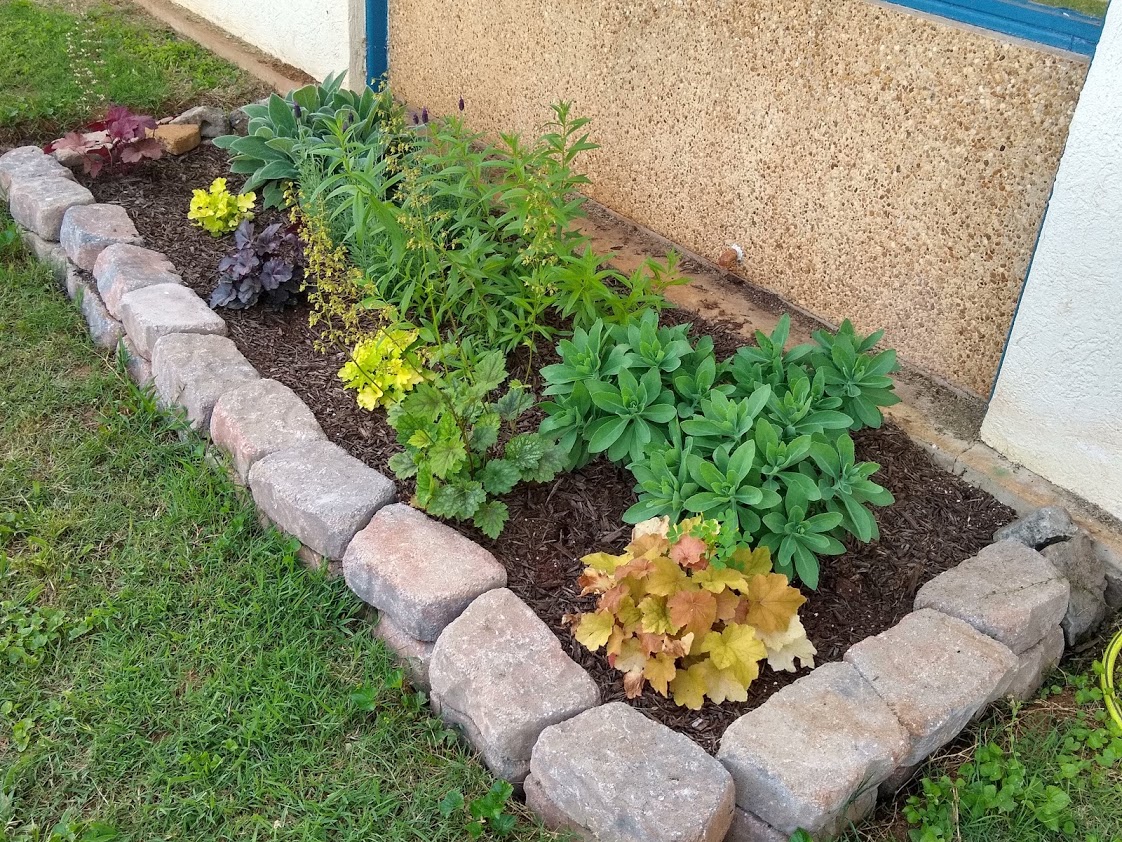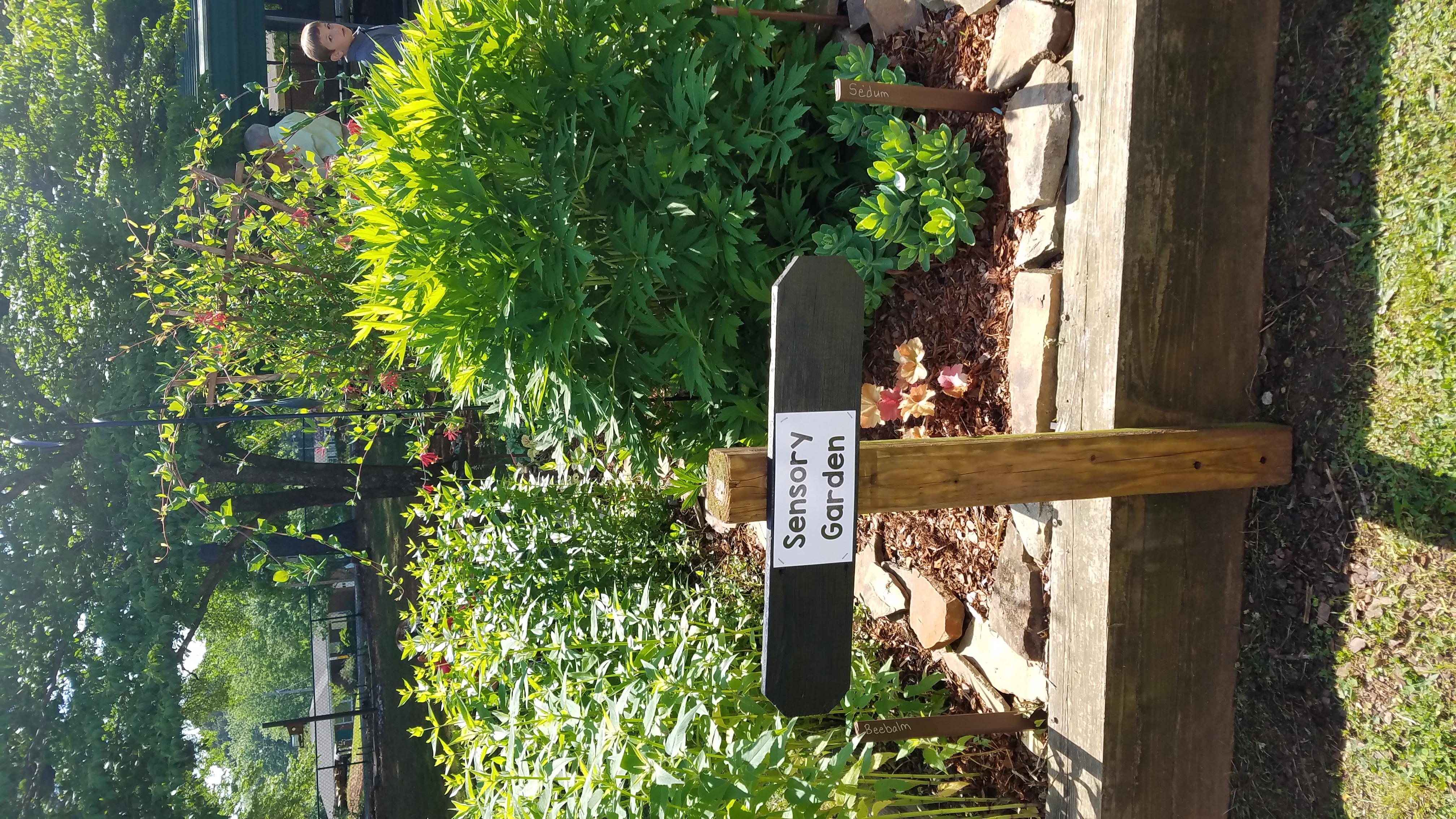Outdoor Learning Station: Sensory Garden
A sensory garden includes plants that help teach students how to use all five senses as they explore the outdoor classroom. Different plants have bright flowers or leaves to trigger a visual response, while other plants feel, taste, or smell unique. If you don’t already have wind chimes in your garden consider adding them so students can see how wind moves them. This will also help them listen for birds visiting the garden as it helps hone their sense of hearing.
Sensory Suggestions | Materials Budget | Plants & Plant ID Signs | Construction Instructions |
Educational Sign & QR Code | Activity Resources | Maintenance Tips | Example Photos
Sensory Suggestions
Below are suggestions to stimulate each of the 5 senses:
Sight: Try to have a mix of energizing and restful colors. Be sure to group plants in clusters but remember to use contrast when selecting items. Plants that attract bright butterflies are generally good choices but don’t limit yourself to plants, brick, gravel, or stone and other non-living items are great for creating visual interest and balance.
Sound: Certain ornamental grasses, as well as man-made additions like wind chimes and water fountains or a bird bath also add to the sounds of the garden.
Smell: herbs like rosemary, lemon verbena, lavender, chocolate mint, scented geraniums, and patchouli plant. Annuals like, four-o-clocks, sweet alyssum, chocolate cosmos, and ageratum are good choices. Or plant perennials like viburnum, abelia, lilac, Plumeria, catmint, gardenia, and creeping phlox.
Feel: annuals like sensitive plant, succulents, licorice plants, silver falls, dusty miller, and chenille plant. Or choose perennials like silver mound, lambs ear, fountain grass, feather grass, and Irish moss.
Taste: stevia, daylilies, hibiscus, sunflowers, nasturtiums, pansies, and borage. Be sure to ID/ separate the edible plants from the others. Alternatively, plant fruit bushes/trees and vegetables like lettuce, swiss chard, peas, spinach, arugula, beet greens, chives, and herbs.
Materials Budget
This free Materials List and Budget document include location suggestions, materials lists, estimated budgets, and plant suggestions:
Plant Suggestions & Plant ID Signs with QR Codes
Check out more of our suggested plants for your sensory garden on our "OC Plants" webpage.
Construction Instructions
These free Construction Instructions documents include a list of Construction Tools & Supplies for Outdoor Classroom Build Day as well as construction and planting instructions:
Educational Sign & QR Code
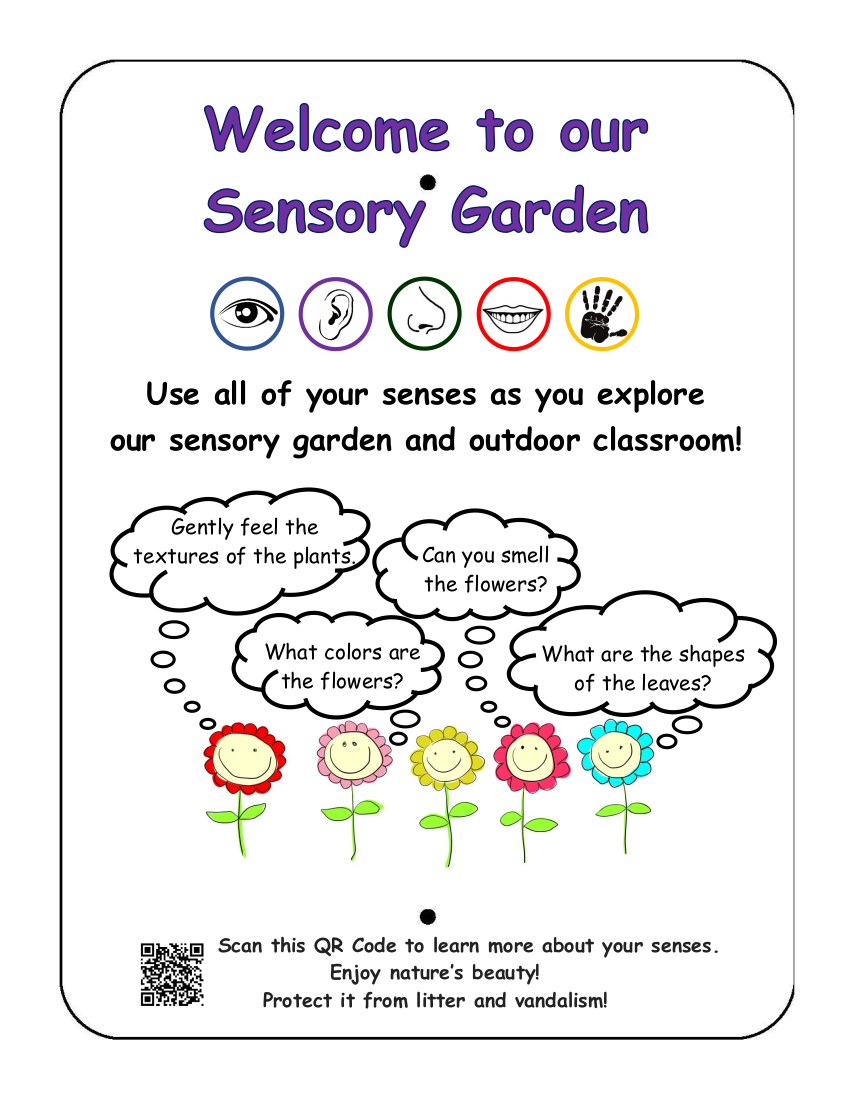
CLICK HERE to download the QR Code for this webpage.
You can inlcude the QR Code on the educational sign for your sensory garden in your outdoor classroom: PDF | Word Doc
Activity Resources
Below are free activity sources related to senses:
AWF's Outdoor Classroom Field Investigation Activities
Maintenance Tips
To allow classes to adopt the Sensory Garden, use this Sensory Garden Adoption Form (Word Doc | PDF), along with the maintenance tips below:
To create a map of your school's Sensory Garden, use this Example Learning Station Map & Plant ID Form
(Word Doc | PDF).
Example Photos
Questions: Contact the AWF at oc@alabamawildlife.org. .
Sensory Suggestions | Materials Budget | Plants & Plant ID Signs | Construction Instructions |
Educational Sign & QR Code | Activity Resources | Maintenance Tips | Example Photos
Sensory Suggestions
Below are suggestions to stimulate each of the 5 senses:
Sight: Try to have a mix of energizing and restful colors. Be sure to group plants in clusters but remember to use contrast when selecting items. Plants that attract bright butterflies are generally good choices but don’t limit yourself to plants, brick, gravel, or stone and other non-living items are great for creating visual interest and balance.
Sound: Certain ornamental grasses, as well as man-made additions like wind chimes and water fountains or a bird bath also add to the sounds of the garden.
Smell: herbs like rosemary, lemon verbena, lavender, chocolate mint, scented geraniums, and patchouli plant. Annuals like, four-o-clocks, sweet alyssum, chocolate cosmos, and ageratum are good choices. Or plant perennials like viburnum, abelia, lilac, Plumeria, catmint, gardenia, and creeping phlox.
Feel: annuals like sensitive plant, succulents, licorice plants, silver falls, dusty miller, and chenille plant. Or choose perennials like silver mound, lambs ear, fountain grass, feather grass, and Irish moss.
Taste: stevia, daylilies, hibiscus, sunflowers, nasturtiums, pansies, and borage. Be sure to ID/ separate the edible plants from the others. Alternatively, plant fruit bushes/trees and vegetables like lettuce, swiss chard, peas, spinach, arugula, beet greens, chives, and herbs.
Materials Budget
This free Materials List and Budget document include location suggestions, materials lists, estimated budgets, and plant suggestions:
Plant Suggestions & Plant ID Signs with QR Codes
- *Plants with *asterisk* have customized plant identification signs with unique scannable QR Codes linked to Student Exploration webpages on AWF's website that includes a description of the plant, photos of the plant, maintenance tips, and the ecological benefits that species provides.
- Plants that are bolded are NATIVE to Alabama and provide the best food sources for our native wildlife.
| Sight | |||
| Clover | Bleeding Heart | *Narrowleaf Sunflower | *Stokes Aster |
| *Pink Muhly Grass | Oxeye Daisy | *Dense Blazing Star | *Eastern Red Columbine |
| Taste | |||
| Chocolate cosmos | Pineapple Sage | *Spearmint | Wild Strawberry |
| Swiss Chard | Lettuces | Chives | Arugula |
| Touch | |||
| *Lamb’s Ear (*only need 1) | Feather Grass | Maidenhair Fern | Sensitive Plant |
| Silver Mound | Sphagnum Moss | *Autumn Joy Sedum | Fountain Grass |
| Smell | |||
| *Rosemary (*only need 1) | *Lavender | Lemon Balm | Orange Mint |
| Creeping Phlox | Patchouli | Lemon Verbena | Lilac |
Check out more of our suggested plants for your sensory garden on our "OC Plants" webpage.
Construction Instructions
These free Construction Instructions documents include a list of Construction Tools & Supplies for Outdoor Classroom Build Day as well as construction and planting instructions:
Educational Sign & QR Code

CLICK HERE to download the QR Code for this webpage.
You can inlcude the QR Code on the educational sign for your sensory garden in your outdoor classroom: PDF | Word Doc
Activity Resources
Below are free activity sources related to senses:
AWF's Outdoor Classroom Field Investigation Activities
- Using Your Senses (all grades): (Word Doc / PDF) Students explore the outdoor classroom using their five senses, and record their observations.
- My Observation Station: Students use observation skills to look, listen, feel, and smell for items from their own observation station that is distanced at least 6' from others students' and then write a poem about their observations.
Maintenance Tips
To allow classes to adopt the Sensory Garden, use this Sensory Garden Adoption Form (Word Doc | PDF), along with the maintenance tips below:
To create a map of your school's Sensory Garden, use this Example Learning Station Map & Plant ID Form
(Word Doc | PDF).
Example Photos
|
|
||
Questions: Contact the AWF at oc@alabamawildlife.org. .
 Wildlife Tag
Wildlife Tag
